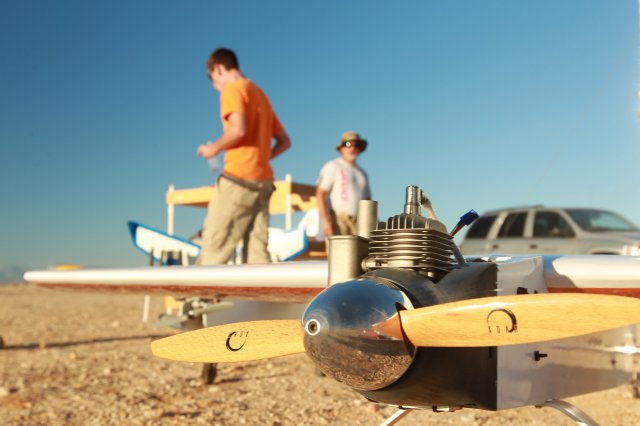 The Marine Corps provided support for the Air Force during their Commander’s Challenge 2012, held at the Combat Center’s Range 220 Sept. 13, 2012.
The Marine Corps provided support for the Air Force during their Commander’s Challenge 2012, held at the Combat Center’s Range 220 Sept. 13, 2012.
The Commander’s Challenge is an annual contest that challenges a group of engineers, with Air Force, to come up with a solution to a warfighting problem presented by the Air Force Material Command. These ideas are then applied to real world issues. Previous challenges have included problems such as forward operating base protection, deep canyon surveillance and identification of the enemy through facial recognition.
This year’s challenge was to find a way to detect and track a small unmanned aircraft through an urban environment.
Systems already used to detect manned aircraft or larger UAS usually involve radar and cannot be used with the surrounding buildings of an urban environment. The answer to this problem would help in security both overseas and domestically.
“Most of the time what they’ll do is reach out to the war fighter,” said Bud Cline, project manager, Advanced Weapons Modernization, Arinc, Incorporated. “Folks that just got back from a deployment, they’ll talk to those guys, ‘Hey what are you seeing out there, here’s what we’re trying to fix, what would make your job easier out there.’”
Two six-man teams were selected, one team worked from Edwards Air Force Base, Calif., and the other from Wright-Patterson Air Force Base, Ohio. Each team was made up of both airmen and civil service workers.
“What they’re looking for are young engineers or professionally degreed people that can contribute. Mathematicians, logistics, all the disciplines of engineering,” Cline said. “It depends on the challenge but they are looking for the expert that’s going to be able to contribute the most.”
Both airmen and civil service workers sent in a resume to join the challenge. The resumes were reviewed and the best candidates for the job were selected to join one of two teams. Airmen looking to join must be O-3 or below and civilians must have less than five years of experience.
“We are looking for fresh ideas,” Cline said. “We don’t want someone that’s been in the Air Force for 30 years that thinks, ‘We have to do it this way. We can’t change from that.’”
They were granted a budget of $75,000 and are given six months to solve the problem.
Over the course of the six-month challenge, each team came up with their own way of getting around the obstacles in the detection and tracking of these aircraft.
“It was 10 to 12 hours a day, six days a week,” said Andre Leone, team leader, Edwards Base team.
All their hard work and innovation led to the final test at the Combat Center’s training areas.
Range 220’s Military Operations On Urban Terrain town provided an area to mimic a city as each answer to the challenge was tested.
“We looked at six or seven different urban environments and this was the best we found,” Cline said.
The Edwards Base team started off the competition. They used four different sensors to achieve a good tracking method of the UAS.
The team used radar for the long-range detection outside the city canyons, an acoustic sweep for close range detection, video cameras for a visual on the target and finally a RF Geolocation, a sensor that detects video downlink signals from the UAS.
All the information gathered from the different sensors are run together into a central processor and fused to produce a single track.
This simplification of the data allows one person to run the system from a single laptop.
The Wright-Patterson team used a combination of distributing systems and sensors that worked off each other’s strengths and weaknesses to detect and track the UAS.
Their main technique used a unique feature, acoustic notes. Sensors around Range 220 analyzed the noise of the aircraft from initial detection to tracking it through the city.
The frequency analysis used algorithms to detect the specific harmonics of the small aircraft and follow it.
“Car and motorcycle engines will have harmonics but will be at a different frequency,” said Dan Gallagher, electrical engineer, Air Force Research Labs, and member of the Wright-Patterson team. “The higher pitch buzz of the UAS will also be at a higher frequency.”
The tracking of the craft through harmonics was backed up by visual confirmation of both cameras and ground sighting.
The team developed an application for android phones that can be distributed to various people around the city.
“Say you can have a police force. You can have them download an app to their phone and if they happen to see the aircraft they break out their phones and it helps track the craft,” Gallagher said.
In the end, Wright-Patterson team’s technology put them ahead, naming them the victors of the Commander’s Challenge 2012.
But the losing team’s work was not wasted.
The challenge combines the ideas of both teams to create the best system possible. The ideas developed during the challenge go on to help service members across the branches.
“This was a wonderful opportunity,” Leone said. “We were really glad to come out here and be a part of it.”
Photo: an unmanned aircraft sits while airmen and civil service workers prepare to test their experiments detecting UAVs at Range 220. Credit: Lance Cpl. Ali Azim
Source: Dvidshub
